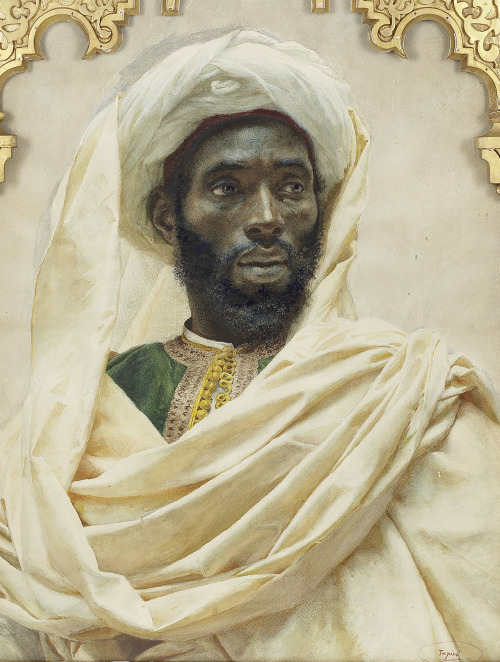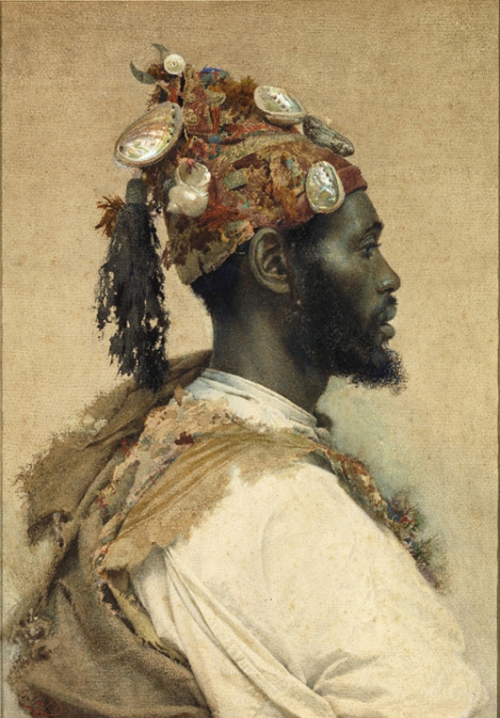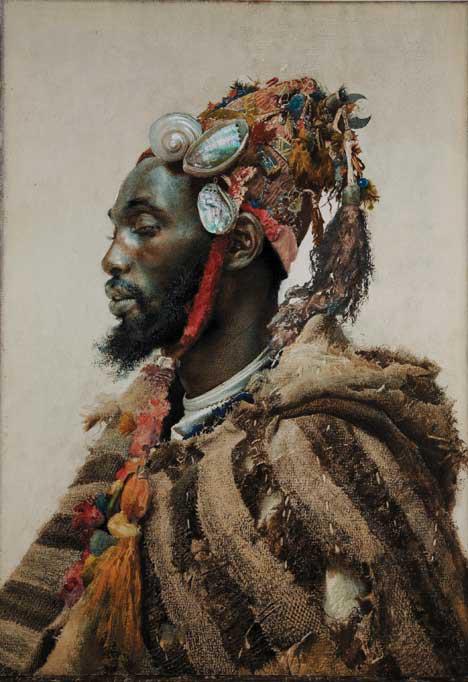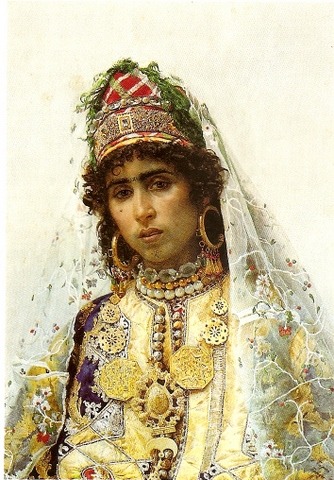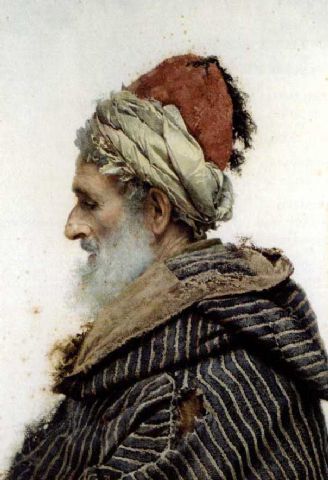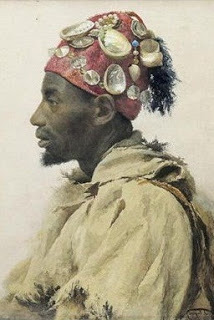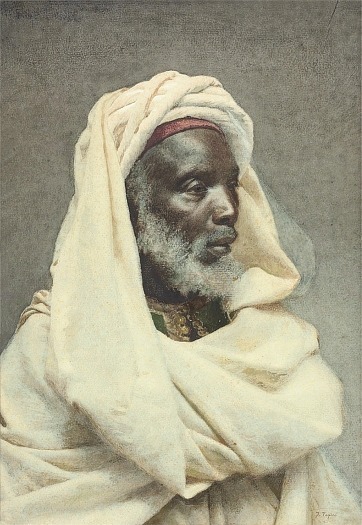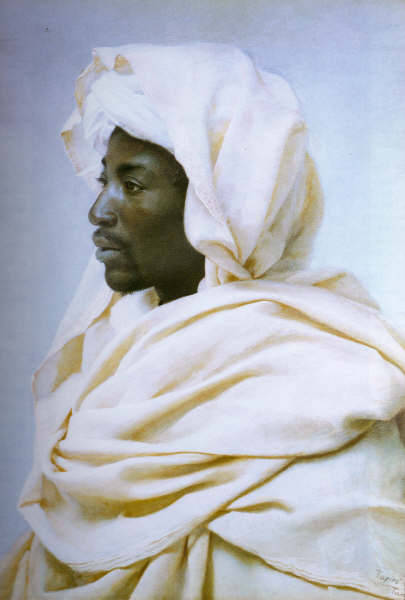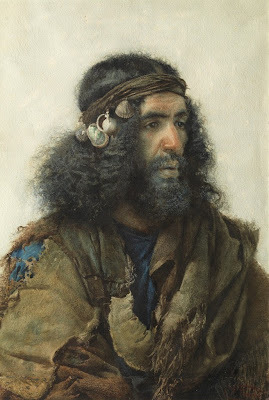"Our myths tell us that if we were Africans and not citizens of a former European colony called Niger, we would not sell our African uranium to Europeans at prices dictated by themselves. If we were Africans we would sell no raw resources at all. Knowing that resources are the mothers of industries, the grandmothers of jobs, and the great-grandmothers of prosperity, we would want prosperity, jobs and industries here at home where we live, so that our younger generations could have the choice of living, working and prospering here at home with us, instead of being condemned to go abroad, chasing the resources we so foolishly sell, in a vain attempt to catch a little bit of wealth we throw away. If we were Africans, our young could travel to other countries as tourists after a year of profitable work at home, instead of stowing away in a suicidal search for jobs abroad."
p.260, The Eloquence of the Scribes, Ayi Kwei Armah
Absorbing AND Throwing Up
To retrieve prior work you have done [in windows] two things are requried: 1) name and 2) location.
This hard drive memory retreival is Sankofa too.
"This is work for creative spirits: finding out about Africa, exploring what values have proved positive in the past, and which have proved poisonous, so we can absorb the positive and throw up the poisonous, as we ready ourselves to imagine our new society, and then to create it."
p258. The Eloquence of the Scribs, Ayi Kwei Armah
This hard drive memory retreival is Sankofa too.
"This is work for creative spirits: finding out about Africa, exploring what values have proved positive in the past, and which have proved poisonous, so we can absorb the positive and throw up the poisonous, as we ready ourselves to imagine our new society, and then to create it."
p258. The Eloquence of the Scribs, Ayi Kwei Armah
Cultural Workers...in the world the slavers made.
Cultural workers intent on laying the groundwork for an African future need only start by stating the historical truth: the history we have shared with Europe has been a tale of pillage, massacres, dehumanization. That Europeans want to interpret it as a civilizing mission and an aid expedition to rescue us from barbarism is natural. What is unnatural is that we should want to repeat their take on our history. There was a time when African intellectuals who knew our history were too beaten down to speak up, and when those trained to speak in the world the slavers made knew only how to repeat their teachers' words.
Now some of us have finished our mimetic training, made contact with the silenced voices uttering our history, and are ready to tell our story on the basis of our historical truth. A politician speaking truth in the present dispensation will quickly be helped to a premature rendezvous with our ancestors. Europeans will plan the murder, and since we are poor and do not know how to make money from creative work, they will find many of us willing to execute it for a few thousand dollars, francs, marks or pounds. Cultural workers do not pose a clear and present danger to our oppressors. If our work is any good, we will suffer only the milder kinds of murder: character assassination, financial destruction. It's a price cultural workers throughout history have paid for real work. If we wish to do the necessary work, we would be foolish to want to avoid the consequence. The best we might do is to create networks guaranteeing improved chances of our survival. That is what all living beings do.
What, with this focus on historical truth, might cultural workers contribute to the construction of an African identity? Our contribution to the future might begin with a hard-eyed look at the shaping structures we inhabit. It is possible to date these structures. It is necessary that they be acknowledged as dated. Beyond that, we need to think of the nature of human movement on this continent before it was divided up into the slave pens Europeans called colonies then, and unimaginative Africans are urged to call nations now, to our constant detriment.
~p240, The Eloquence of the Scribes, Ayi Kwei Armah
Established Falsehood
"...I could not shake the image of the destroyed Biko from my mind: an unwary seeker after knowledge, eager to reveal what he was discovering on his own. He had run into a wall of prejudice dressed up as expert knowledge, armed with the lethal power to destroy any seeker straying off the brightly lit highways of established falsehood.
Orthodox scholars in authority called ancient Egyptian linkages with Africa controversial. A code word meaning unacceptable, used by those who still felt they needed to be polite in their hostility. Those laboring under no such scruples, feeling they could speak their prejudices with no fear of disavowal from anyone with power over them, called the linkages arrant nonsense."
~p. 62 Kmt: In the House of Life, Ayi Kwei Armah
Orthodox scholars in authority called ancient Egyptian linkages with Africa controversial. A code word meaning unacceptable, used by those who still felt they needed to be polite in their hostility. Those laboring under no such scruples, feeling they could speak their prejudices with no fear of disavowal from anyone with power over them, called the linkages arrant nonsense."
~p. 62 Kmt: In the House of Life, Ayi Kwei Armah
The Blood of the Impure
The Blood of the Impure:
 Post by Laurent DuboisThe French national anthem, La Marseillaise, is, if you think about it, a pretty nasty song. It dreams, in one of its more memorable verses, that the “blood of the impure” will “irrigate our fields.” It’s a rousing anthem, to be sure, and I myself can frequently be heard humming it to myself in advance of a match being played by Les Bleus, or as I ride my bike or do the dishes. I’ve found that it’s sometimes hard to find a French person (at least if you hang out, as I do, with too many intellectuals), who can actually sing it without irony. And yet, over the past 26 years, the question of whether a particular subset of French men – those who play on the national football team – sing the Marseillaise under certain conditions has been a rather unhealthy obsession in France (we’ve blogged about it before, when Kinshasa-born flanker Yannick Nyanga sobbed uncontrollably during the anthem ahead of a rugby match vs Australia last year).
Post by Laurent DuboisThe French national anthem, La Marseillaise, is, if you think about it, a pretty nasty song. It dreams, in one of its more memorable verses, that the “blood of the impure” will “irrigate our fields.” It’s a rousing anthem, to be sure, and I myself can frequently be heard humming it to myself in advance of a match being played by Les Bleus, or as I ride my bike or do the dishes. I’ve found that it’s sometimes hard to find a French person (at least if you hang out, as I do, with too many intellectuals), who can actually sing it without irony. And yet, over the past 26 years, the question of whether a particular subset of French men – those who play on the national football team – sing the Marseillaise under certain conditions has been a rather unhealthy obsession in France (we’ve blogged about it before, when Kinshasa-born flanker Yannick Nyanga sobbed uncontrollably during the anthem ahead of a rugby match vs Australia last year).
We are now being treated to what feels to me like Act 467 of this drama. Karim Benzema, as anyone who attentively watches French football matches knows, doesn’t sing the anthem before matches. In a recent interview, asked why, he answered in a pleasingly flippant way: “It’s not because I sing that I’m going to score three goals. If I don’t sing the Marseillaise, but then the game starts and I score three goals, I don’t think at the end of the game anyone is going to say that I didn’t sing the Marseillaise.” Pushed further on the question, he invoked none other than Zinedine Zidane who, like Benzema, was the child of Algerian immigrants to France – and who also happens to be the greatest French footballer of all time, and the one to whom the team owes its one little star on its jersey: “No one is going to force me to sing the Marseillaise. Zidane, for instance, didn’t necessarily sing it. And there are others. I don’t see that it’s a problem.”
Ah, Karim, but it is a problem, don’t you see? In fact, your decision about whether to vocalize or not, as you stand in line under the careful scrutiny of cameras, about to enter into a hyper-stressful and aggressive sporting match during which your every action will be dissected and discussed, is an unmistakable sign about whether or not the true France will survive or alternatively be submerged in a tide of unruly immigrants and their descendants.
Notwithstanding the fact that, as Michel Platini has noted, in his generation no footballers ever sang the Marseillaise, and that “white” footballers – even the Muslim Franck Ribéry, who at best mutters a bit during the anthem but is much more enthusiastic in his pre-game prayers to Allah – are rarely if ever asked this particular question, even so some will continue to insist that your choice not to sing is a window onto your disloyal soul. As the Front National explained: “This football mercenary, paid 1484 Euros per hour, shows an inconceivable and inacceptable disdain for the jersey that he is lucky to be able to wear. Karim Benzema does not “see the problem” with not singing the Marseillaise. Well, French people wouldn’t see any problem with having him no longer play for the French team.”
Some genealogy is in order here. In 1996, Jean-Marie Le Pen first levied this accusation against the French team. France was playing in the European Cup, and playing well. But he was a bit disturbed by something he saw: an awful lot of them seemed, well, not really to be French. “It’s a little bit artificial to bring in foreign players and baptize them ‘Equipe de France,’” he opined. The team, he went on – with blithe disregard for the bald falsity of what he was saying, since no one can play on the French team who is not a French citizen, and nearly all of the players had in any case been born in France – was full of “fake Frenchmen who don’t sing the Marseillaise or visibly don’t know it.” When pressed on these comments a few days later, he lamented that while players from other countries in the tournament sang their anthems, “our players don’t because they don’t want to. Sometimes they even pout in a way that makes it clear that it’s a choice on their part. Or else they don’t know it. It’s understandable since no one teaches it to them.” [For more on this, see Laurent's excellent book, Soccer Empire -- Ed]
The response to Le Pen’s 1996 comments was immediate and resounding: everyone, or almost everyone, called him an idiot. Politicians, pundits, and journalists all piled on, falling over themselves to denounce his comments and declare their love for the French team. In fact he managed to do something rather extraordinary with his comments, pushing a group of athletes – most of whom would likely have never made public political statements about the questions of race, immigration, and identity in France – to become activists of a kind.
Christian Karembeu – from the Pacific territory of New Caledonia – made a decision. “From that on, I didn’t sign the Marseillaise. To raise people’s consciousness, so that everyone will know who we are.” He knew the words perfectly, he explained. “In the colonies, everyone has to learn the Marseillaise by heart at school. That means that I, from zero to twenty-five years old, knew the Marseillaise perfectly.” But when he heard the song, Karembeu explained, he thought “about his ancestors” – indigenous Kanaks who had been drafted in New Caledonia and died on the battlefields of World War I for France. “The history of France is that of its colonies and its wealth. Above all, I am a Kanak. I can’t sign the French national anthem because I know the history of my people.”
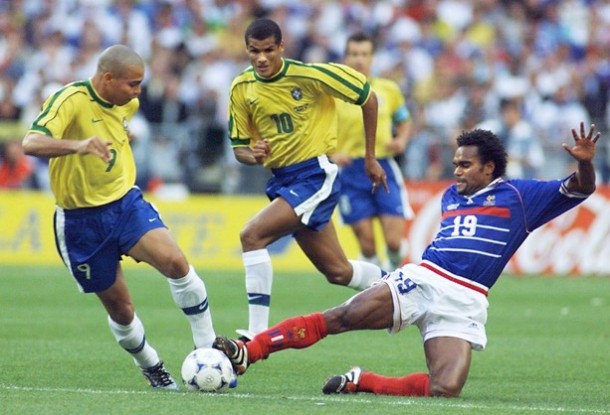 One of Karembeu’s teammates, the Guadeloupe-born Lilian Thuram, also experienced the event as a kind of political awakening. He made a different choice when it came to the song: he always sang it loudly, and famously off tune, often with tears in his eyes. But doing so was part of a political stance that overlapped with Karembeu’s: in the next years, Thuram became a powerful and potent voice criticizing Le Pen, and later Nicholas Sarkozy, and advocating for acknowledgment, study, and confrontation with the past of slavery and colonialism. In his retirement, he has – in a move that, to say the least, is not the usual path taken by post-career athletes – devoted himself to anti-racist education, and recently curated an exhibit at the Quai Branly outlining the history of colonial and racial representations of “the Other.”
One of Karembeu’s teammates, the Guadeloupe-born Lilian Thuram, also experienced the event as a kind of political awakening. He made a different choice when it came to the song: he always sang it loudly, and famously off tune, often with tears in his eyes. But doing so was part of a political stance that overlapped with Karembeu’s: in the next years, Thuram became a powerful and potent voice criticizing Le Pen, and later Nicholas Sarkozy, and advocating for acknowledgment, study, and confrontation with the past of slavery and colonialism. In his retirement, he has – in a move that, to say the least, is not the usual path taken by post-career athletes – devoted himself to anti-racist education, and recently curated an exhibit at the Quai Branly outlining the history of colonial and racial representations of “the Other.”
Le Pen’s comments were also a case of spectacularly bad timing. Though France didn’t win the European Cup, a team made up of most of the same players did the unthinkable in 1998 and won the World Cup in Paris. This victory would, in any situation, have been greeted with an outpouring of joy. But thanks largely to Le Pen’s comments – and to the fact that it was Thuram and Zidane – who scored the pivotal goals in the semi-final and final, the event was greeted by many in France as a powerful celebration of a new multi-cultural and multi-ethnic nation. There was an outpouring of comments from all sides that saw, in the team, precisely the opposite of what Le Pen had suggested: a France which, thanks to the contributions of all its different peoples, of all backgrounds, had won a critical victory.
Zinedine Zidane, for instance, reflected on the World Cup victory as a moment of consolidation and reconciliation for him and his family, and more broadly for Algerians and their descendants in France, many of whom waved Algerian flags to celebrate. “There was something very moving about seeing all those Algerian flags mixed in with the French ones in the streets on the night of our victory. This alchemy of victory proved suddenly that my father and mother had not made the journey for nothing: it was the son of a Kabyle that offered up the victory, but it was France that became champion of the world. In one goal by one person, two cultures became one.” The victory was “the most beautiful response to intolerance.” He described the victory as an explicit response to Le Pen: “Frankly, what does it matter if you belt out the Marseillaise or if you live it inside yourself? … Do we have to belt out this warrior’s song to be patriotic?”
It is, perhaps, this Zidane that Benzema was trying to channel in his comments. Of course, they come at a very different time. Zidane could speak from the pinnacle of victory. Benzema speaks in the midst of a long period of relative failure on the part of the French team – the debacle of 2010, the ultimate disappointment of the European Cup last summer, and now an ongoing struggle to qualify for 2014 in Brazil. The current debate about the Marseillaise, too, is haunted by the many controversies surrounding the booing of the anthem during matches pitting France against Algeria, Tunisia, and Morocco over the past years. In September 2001, after pro-Algeria fans invaded the pitch during a game against France, Le Pen once again used football as a touchstone for his political campaign, this time with more success. He announced his candidacy for president in front of the Stade de France a few weeks later, explaining he had chosen the site because it was where “our national anthem was booed.” The next year, he made it into the second round of the presidential election, forcing the French to choose between him and Jacques Chirac. The French team mobilized again, with even Zidane urging people to vote against Le Pen.
We might imagine that there is, somewhere in the Front National office, presumably some kind of little file, or perhaps a handbook, on how to take advantage of various incidents on the football pitch for political gain. And one can predict that, like Benzema, future footballers who – because of the accident of their ancestry – are be suspected of disloyalty by French xenophobes will be asked this same question again and again: “Why don’t you sing the Marseillaise?” They’ll be able to look back to find various ways to answer the question, and indeed will have quite the menu: do you politely offer a “Va te faire foutre!” with sauce Karembeu, Thuram, Zidane, or Benzema? Eventually, one might be able to offer an entire seminar on the meaning and performance of nationalism using nothing but examples from the debate about football and the Marseillaise. The field of French Cultural Studies will eventually acknowledge that Jean-Marie Le Pen has been our greatest friend over the years, a generative thinker without whom we might have little to write about.
In the meantime, on the pitch France will need all the help it can get as they are about to take on reigning World and double European champions Spain. Many fans will probably be open to the players using any form of inspiration they might need in order to score some goals and win this critical game, so that they won’t put us all through the usual torture of dragging out qualification until the last minute. (Remember the hand of Henry?)
Do they want to pray to Allah, Jesus, Zarathustra? Be our guest. Invoke their Ancestors the Gauls, channel the spirit of the founder of the World Cup, the Frenchman Jules Rimet, or call down the West African warrior god Ogun? Fine with us. At the end of the game, as Benzema has pointed out, if they’ve scored three goals and pull off a win, no one will remember what they were singing when the game began.
* Laurent Dubois, professor of history at Duke University, blogs at Soccer Politics and is a member of the Football is a Country collective. His book Soccer Empire: The World Cup and the Future of France comes highly recommended.


 Post by Laurent Dubois
Post by Laurent DuboisWe are now being treated to what feels to me like Act 467 of this drama. Karim Benzema, as anyone who attentively watches French football matches knows, doesn’t sing the anthem before matches. In a recent interview, asked why, he answered in a pleasingly flippant way: “It’s not because I sing that I’m going to score three goals. If I don’t sing the Marseillaise, but then the game starts and I score three goals, I don’t think at the end of the game anyone is going to say that I didn’t sing the Marseillaise.” Pushed further on the question, he invoked none other than Zinedine Zidane who, like Benzema, was the child of Algerian immigrants to France – and who also happens to be the greatest French footballer of all time, and the one to whom the team owes its one little star on its jersey: “No one is going to force me to sing the Marseillaise. Zidane, for instance, didn’t necessarily sing it. And there are others. I don’t see that it’s a problem.”
Ah, Karim, but it is a problem, don’t you see? In fact, your decision about whether to vocalize or not, as you stand in line under the careful scrutiny of cameras, about to enter into a hyper-stressful and aggressive sporting match during which your every action will be dissected and discussed, is an unmistakable sign about whether or not the true France will survive or alternatively be submerged in a tide of unruly immigrants and their descendants.
Notwithstanding the fact that, as Michel Platini has noted, in his generation no footballers ever sang the Marseillaise, and that “white” footballers – even the Muslim Franck Ribéry, who at best mutters a bit during the anthem but is much more enthusiastic in his pre-game prayers to Allah – are rarely if ever asked this particular question, even so some will continue to insist that your choice not to sing is a window onto your disloyal soul. As the Front National explained: “This football mercenary, paid 1484 Euros per hour, shows an inconceivable and inacceptable disdain for the jersey that he is lucky to be able to wear. Karim Benzema does not “see the problem” with not singing the Marseillaise. Well, French people wouldn’t see any problem with having him no longer play for the French team.”
Some genealogy is in order here. In 1996, Jean-Marie Le Pen first levied this accusation against the French team. France was playing in the European Cup, and playing well. But he was a bit disturbed by something he saw: an awful lot of them seemed, well, not really to be French. “It’s a little bit artificial to bring in foreign players and baptize them ‘Equipe de France,’” he opined. The team, he went on – with blithe disregard for the bald falsity of what he was saying, since no one can play on the French team who is not a French citizen, and nearly all of the players had in any case been born in France – was full of “fake Frenchmen who don’t sing the Marseillaise or visibly don’t know it.” When pressed on these comments a few days later, he lamented that while players from other countries in the tournament sang their anthems, “our players don’t because they don’t want to. Sometimes they even pout in a way that makes it clear that it’s a choice on their part. Or else they don’t know it. It’s understandable since no one teaches it to them.” [For more on this, see Laurent's excellent book, Soccer Empire -- Ed]
The response to Le Pen’s 1996 comments was immediate and resounding: everyone, or almost everyone, called him an idiot. Politicians, pundits, and journalists all piled on, falling over themselves to denounce his comments and declare their love for the French team. In fact he managed to do something rather extraordinary with his comments, pushing a group of athletes – most of whom would likely have never made public political statements about the questions of race, immigration, and identity in France – to become activists of a kind.
Christian Karembeu – from the Pacific territory of New Caledonia – made a decision. “From that on, I didn’t sign the Marseillaise. To raise people’s consciousness, so that everyone will know who we are.” He knew the words perfectly, he explained. “In the colonies, everyone has to learn the Marseillaise by heart at school. That means that I, from zero to twenty-five years old, knew the Marseillaise perfectly.” But when he heard the song, Karembeu explained, he thought “about his ancestors” – indigenous Kanaks who had been drafted in New Caledonia and died on the battlefields of World War I for France. “The history of France is that of its colonies and its wealth. Above all, I am a Kanak. I can’t sign the French national anthem because I know the history of my people.”
 One of Karembeu’s teammates, the Guadeloupe-born Lilian Thuram, also experienced the event as a kind of political awakening. He made a different choice when it came to the song: he always sang it loudly, and famously off tune, often with tears in his eyes. But doing so was part of a political stance that overlapped with Karembeu’s: in the next years, Thuram became a powerful and potent voice criticizing Le Pen, and later Nicholas Sarkozy, and advocating for acknowledgment, study, and confrontation with the past of slavery and colonialism. In his retirement, he has – in a move that, to say the least, is not the usual path taken by post-career athletes – devoted himself to anti-racist education, and recently curated an exhibit at the Quai Branly outlining the history of colonial and racial representations of “the Other.”
One of Karembeu’s teammates, the Guadeloupe-born Lilian Thuram, also experienced the event as a kind of political awakening. He made a different choice when it came to the song: he always sang it loudly, and famously off tune, often with tears in his eyes. But doing so was part of a political stance that overlapped with Karembeu’s: in the next years, Thuram became a powerful and potent voice criticizing Le Pen, and later Nicholas Sarkozy, and advocating for acknowledgment, study, and confrontation with the past of slavery and colonialism. In his retirement, he has – in a move that, to say the least, is not the usual path taken by post-career athletes – devoted himself to anti-racist education, and recently curated an exhibit at the Quai Branly outlining the history of colonial and racial representations of “the Other.”Le Pen’s comments were also a case of spectacularly bad timing. Though France didn’t win the European Cup, a team made up of most of the same players did the unthinkable in 1998 and won the World Cup in Paris. This victory would, in any situation, have been greeted with an outpouring of joy. But thanks largely to Le Pen’s comments – and to the fact that it was Thuram and Zidane – who scored the pivotal goals in the semi-final and final, the event was greeted by many in France as a powerful celebration of a new multi-cultural and multi-ethnic nation. There was an outpouring of comments from all sides that saw, in the team, precisely the opposite of what Le Pen had suggested: a France which, thanks to the contributions of all its different peoples, of all backgrounds, had won a critical victory.
Zinedine Zidane, for instance, reflected on the World Cup victory as a moment of consolidation and reconciliation for him and his family, and more broadly for Algerians and their descendants in France, many of whom waved Algerian flags to celebrate. “There was something very moving about seeing all those Algerian flags mixed in with the French ones in the streets on the night of our victory. This alchemy of victory proved suddenly that my father and mother had not made the journey for nothing: it was the son of a Kabyle that offered up the victory, but it was France that became champion of the world. In one goal by one person, two cultures became one.” The victory was “the most beautiful response to intolerance.” He described the victory as an explicit response to Le Pen: “Frankly, what does it matter if you belt out the Marseillaise or if you live it inside yourself? … Do we have to belt out this warrior’s song to be patriotic?”
It is, perhaps, this Zidane that Benzema was trying to channel in his comments. Of course, they come at a very different time. Zidane could speak from the pinnacle of victory. Benzema speaks in the midst of a long period of relative failure on the part of the French team – the debacle of 2010, the ultimate disappointment of the European Cup last summer, and now an ongoing struggle to qualify for 2014 in Brazil. The current debate about the Marseillaise, too, is haunted by the many controversies surrounding the booing of the anthem during matches pitting France against Algeria, Tunisia, and Morocco over the past years. In September 2001, after pro-Algeria fans invaded the pitch during a game against France, Le Pen once again used football as a touchstone for his political campaign, this time with more success. He announced his candidacy for president in front of the Stade de France a few weeks later, explaining he had chosen the site because it was where “our national anthem was booed.” The next year, he made it into the second round of the presidential election, forcing the French to choose between him and Jacques Chirac. The French team mobilized again, with even Zidane urging people to vote against Le Pen.
We might imagine that there is, somewhere in the Front National office, presumably some kind of little file, or perhaps a handbook, on how to take advantage of various incidents on the football pitch for political gain. And one can predict that, like Benzema, future footballers who – because of the accident of their ancestry – are be suspected of disloyalty by French xenophobes will be asked this same question again and again: “Why don’t you sing the Marseillaise?” They’ll be able to look back to find various ways to answer the question, and indeed will have quite the menu: do you politely offer a “Va te faire foutre!” with sauce Karembeu, Thuram, Zidane, or Benzema? Eventually, one might be able to offer an entire seminar on the meaning and performance of nationalism using nothing but examples from the debate about football and the Marseillaise. The field of French Cultural Studies will eventually acknowledge that Jean-Marie Le Pen has been our greatest friend over the years, a generative thinker without whom we might have little to write about.
In the meantime, on the pitch France will need all the help it can get as they are about to take on reigning World and double European champions Spain. Many fans will probably be open to the players using any form of inspiration they might need in order to score some goals and win this critical game, so that they won’t put us all through the usual torture of dragging out qualification until the last minute. (Remember the hand of Henry?)
Do they want to pray to Allah, Jesus, Zarathustra? Be our guest. Invoke their Ancestors the Gauls, channel the spirit of the founder of the World Cup, the Frenchman Jules Rimet, or call down the West African warrior god Ogun? Fine with us. At the end of the game, as Benzema has pointed out, if they’ve scored three goals and pull off a win, no one will remember what they were singing when the game began.
* Laurent Dubois, professor of history at Duke University, blogs at Soccer Politics and is a member of the Football is a Country collective. His book Soccer Empire: The World Cup and the Future of France comes highly recommended.
Monkeys Stay Away from Mean People

[ *not racial impression...such ism is uniquely h. sapien sapien. But racism can be unhelpful. ]Given the choice between accepting goodies from helpful, neutral or unhelpful people, capuchin monkeys (Cebus apella) tend to avoid individuals who refuse aid to others, according to a study published today in Nature Communications.By Helen Shen and Nature magazine
“Humans can build up an impression* about somebody just based on what we see,” says author James Anderson, a comparative psychologist at the University of Stirling, UK. The capuchin results suggest that this skill “probably extends to other species”, he says.
Anderson chose to study capuchins because of their highly social and cooperative instincts. Monkeys in the study watched as a person either agreed or refused to help another person to open a jar containing a toy. Afterwards, both people offered a food pellet to the animal. The monkey was allowed to accept food from only one.
When help was given, the capuchins showed little preference between the person requesting help and the one providing aid. But when help was denied, the seven monkeys tended to accept food less often from the unhelpful person than from the requester
.
Rekia Boyd death lawsuit among likely city of Chicago settlements

The city of Chicago could pay $4.5 million to settle a lawsuit filed by the family of a 22-year-old woman killed by an off-duty police officer.
The City Council's finance committee is scheduled to consider the proposed settlement on Monday.
Rekia Boyd's family says she was shot in the back of the head by an off-duty officer in March 2012. The lawsuit alleges the officer drove by Boyd and a group of friends and got into an argument with a man in the group. The officer then fired a gun, hitting Boyd.
The finance committee also is scheduled to address a $1.8 million settlement in the case of a man who says he confessed to two murders because he was tortured by police. His conviction was thrown out in 2007.Smart White Kids

White supremacy does not exist or persist because whites foolishly fear people with a different skin color. it survives and thrives because whiteness delivers unfair gains and unjust enrichments to people who participate in and profit from the existence of a racial cartel that skews opportunities and life chances for their own benefit. it externalizes the worst social conditions onto communities of color and provides whites with a floor below which they cannot fall. - George Lipsitz, The Posessive Investment in Whiteness"...Political Scientist Andrew Hacker asked his students how much money it would take to go from being white to being Black. Most students put a dollar amount of $50 million (or $1 million per year of their life). Whiteness is an enormous enough investment that a cash value can be ascribed to it."
Not true. Count the number of stars in the sky of the cosmos of the neurons in your white mind...multiply that to the 'cash value [that] can be ascribed to [going from being white to being black]. There. You have the value of money it would take to go from being black to white.
"Style has a profound meaning to Black Americans..."
"Style has a profound meaning to Black Americans. If we can’t drive, we will invent walks and the...": “Style has a profound meaning to Black Americans. If we can’t drive, we will invent walks and the world will envy the dexterity of our feet. If we can’t have ham, we will boil chitterlings; if we are given rotten peaches, we will make cobblers; if given scraps, we will make quilts; take away our drums, and we will clap our hands. We prove the human spirit will prevail. We will take what we have to make what we need. We need confidence in our knowledge of who we are.”
- Nikki Giovanni (via funkchunk)
- Nikki Giovanni (via funkchunk)
Germany colonized Namibia in 1884
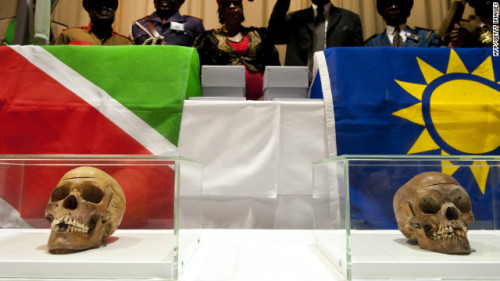
thepeacefulterrorist:
Germany colonized Namibia in 1884 until after the First World War.
In 2004 it offered a formal apology for the massacre of around 65,000 Herero tribes people who sustained a rebellion between 1904 and 1907 before they were forced into the desert where many perished.
In 2011 skulls of Herero and Nama people were returned to Namibia after a ceremony in Berlin.
How Martin Luther King, Jr. Avoided Visiting Israel

Claudia Jones with Dr. Martin Luther King, Jr. in Britain. Jones, a leading organizer and theoretician, was deported from the U.S. to Britain in 1955. She died in 1964 in the UK., a photo by Pan-African News Wire File Photos on Flickr.
http://www.haaretz.com/news/features/how-martin-luther-king-jr-avoided-visiting-israel.premium-1.505277Haaretz | Feb. 23, 2013
How Martin Luther King Jr. avoided visiting Israel
Documents that have come to light 45 years after the assassination of Martin Luther King Jr. show Israel's efforts to woo the civil rights leader – a campaign that never came to fruition.
By Ofer Aderet
The Israel Consul in Atlanta, Zeev Dover, had an interesting idea 50 years ago. In order to bring the State of Israel closer to the "black community," he made a suggestion to the Foreign Ministry: To send books on Judaism and Israel to "the libraries of every black college." Alongside this, Dover recommended inviting African-American lecturers to "black colleges" who "had visited Israel and are familiar with our history." In this way, he hoped Israel could contribute towards "introducing the sophisticated nature of the national movement for the social-cultural regeneration of the people of Israel to this group."
These ideas can be found in a memorandum under the heading "Ties with the black community," sent by the consul to the Israeli Embassy in Washington on November 9, 1962. The memo is part of a selection of documents that deal with Israel's ties with the black community in the United States, and with its failed attempts to host the black leader Martin Luther King in Israel.
These documents were recently released by the State Archives, on the 45th anniversary of King's assassination. Studying them is also relevant during the run-up to the visit of another black leader to these shores – U.S. President Barack Obama.
The internal debate within Israel regarding Martin Luther King was revealed in a classified document that the consul in Atlanta sent to the Washington embassy in August 1962. Exactly a year later, King led the huge demonstration in Washington, where he delivered his historic "I have a dream" speech.
The Israel Consul in Atlanta wrote that he "places great importance on forming connections with the black leadership," but added: "In my opinion the time is not yet ripe for his visit to Israel." He explained that this was because King represents "the militant wing of the civil rights movement," and that important organizations "are not in agreement with him and oppose his methods." He also added that alongside the global fame King had attained, he also had managed to alienate groups of moderate African Americans.
The consul raised the concern that inviting King to Israel would lead to "severe negative responses," and recommended that "in any case, we should not be the first country that gives King so-called international status." He also warned that King's visit to Israel could harm Israel's ties with Southern states in the U.S., who felt threatened by the dominant radical leader. At the end of the memo he recommended "shelving the idea until the right moment," and added "our efforts to enter into discussions with different factors in the black community must be done…without being overly conspicuous."
The next letter he sent on the subject to his superiors at the Foreign Ministry, in November 1962, presented a more complex picture: On the one hand, the black community does not have real impact or importance in the U.S. – and therefore Israel shouldn't go out of its way to woo it. On the other, he noticed the unrest that had begun, and warned that Israel should not ignore it.
"It is important that we define what our specific objectives are towards this population, and accord them the appropriate treatment," he wrote. He added the argument that African-Americans only comprise 11 percent of the population of the U.S., and said that: "despite the high birthrate [they] will remain a minority. Moreover, many more years will pass until this racial minority recovers from the economic and educational backwardness that is the result of discrimination."
When reading the consul's words, it's worth bearing in mind the spirit of the times they were written in. Today they may seem racist and arrogant: "Uniting and driving the Negros is the urge to defend themselves against discrimination and all that entails. It is unlikely that in the near future, the Negros will become a group with the political and economic influence consistent with their numbers in the total population. This is also because of their low average levels of education and affluence, and also since domestic pressures are at the top of their concerns, with the rest of the world taking second place to their struggle for recognition."
However, the consul warned that "we should not ignore this large population," and recommended "fostering contact with all its branches more than ever before." He also said that Israel's main concern should be directed towards "laying the ground for the future."
Among other things, the consul suggested emphasizing the historical similarities between Jews and blacks as persecuted minorities, but added that "our first goal must be, in my opinion, filling the gap in [their] knowledge and clarifying the eternal connection between the Jewish people and their country."
He attached to the letter a list of dozens of American colleges that had black students. "In the southern U.S., blacks are concentrated in their own special colleges, which allows us special access to this sector without the fear of 'discrimination' on our part that could occur after making a special and separate request to students on mixed campuses" he wrote.
While the Israeli government had not yet formulated its final position regarding King, there were other organizations in Israel that hurried to invite him to visit. The Histadrut labor federation received King's confirmation – but for some unknown reason he cancelled his visit. This pattern repeated itself several times over the next few years: Authorities in Israel invited him, he responded in the affirmative, but the visits never took place. In 1964, following the announcement that King was to receive the Nobel Peace Prize, Israeli representatives met with him.
Deputy Prime Minister Abba Eban met with King in Washington and invited him to visit Israel. King accepted, but a date was not set. Five months later, in March 1965, the Israeli ambassador in Washington, Avraham Harman, invited King as an official guest of the Israeli government to visit "on any date at his convenience." This invitation was another that went unfulfilled.
In December that same year, King met with Shimon Yallon, the consul general of Israel in Atlanta. At the start of the meeting King said he had held an "open invitation" to visit Israel for four years, but that his visit had, unfortunately, yet to take place.
Half a year later, King wrote to the Israeli ambassador in Washington. In his letter, he said that he was "very embarrassed" he didn't respond to his request over the course of several months. He justified this as follows: "Just the other day one of my secretaries discovered a large number of letters that had been placed in a folder of 'letters to be filed.'…Your letter was, unfortunately, one of those in that particular folder...I can assure you that it was not due to sheer carelessness but to the pressures of an understaffed and overworked office."
But despite the apology, King ended the letter with a reservation: "At this writing, it is not possible for me to give you a date when I can go there, but I do hope that my schedule will soon ease up so that I can accept an invitation to go to Israel," he wrote to the ambassador.
The trend started to change in 1967. Prime Minister Levi Eshkol wrote to King that he was happy to hear about his coming visit to Israel, and offered government sponsorship for the trip. In May 1967 King responded, saying that he would accept the invitation and that he would be happy to meet the prime minister personally: "Take this means to express my deep appreciation to you for the invitation you extended me to come to your wonderful country," he wrote. The outbreak of the Six-Day War gave him an excuse to cancel the visit again. Less than a year later, in April 1968, he was assassinated.
One can understand why Israel made such efforts to bring about a visit from King – as a visit from a Nobel laureate could have improved Israel's standing in the U.S. and Africa, where he was revered. As to the question of why King did not accept the invitations, there is no clear-cut answer.
"King was sympathetic to Israel and declared support for its right to exist in peace. But given all the delays and evasions, it seems he did not want to identify himself with Israel to this extent during the struggle for equal rights for blacks in the United States," write Shlomo Mark and Hagai Zoref at the State Archives. "It is possible that the fact that during the 1960s his status began to decline in the African-American community, with the rise of more radical groups that were identified with anti-Israel positions, such as Malcolm X and the Black Panthers, also contributed to this," they added.
Senegal campaign preaches ‘black is beautiful
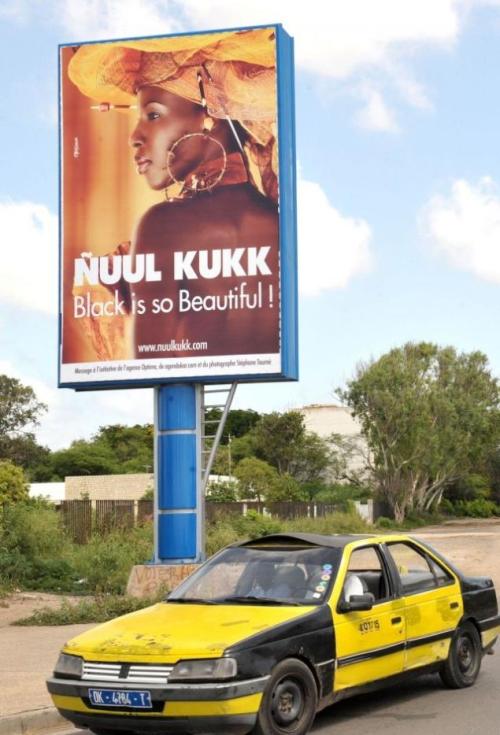
nok-ind:
dynamicafrica:
Senegal campaign preaches ‘black is beautiful’ after ads urge women to bleach skin
Last year’s ‘All White’ ads promoting lightened skin angered activists in Senegal who want women who know bleaching is dangerous. They put up their own ads to tell women that ‘black is so beautiful.’
AFRIKAN Y Chromosome Much Older Than Previously Thought

The discovery and analysis of an extremely rare African American Y chromosome pushes back the time of the most recent common ancestor for the Y chromosome lineage tree to 338,000 years ago. This time predates the age of the oldest known anatomically modern human fossils.
University of Arizona geneticists have discovered the oldest known genetic branch of the human Y chromosome — the hereditary factor determining male sex.
The new divergent lineage, which was found in an individual who submitted his DNA to Family Tree DNA, a company specializing in DNA analysis to trace family roots, branched from the Y chromosome tree before the first appearance of anatomically modern humans in the fossil record. Read more.
Embodier and Inventor...pphhht.
“[G]iven that the “West” presents itself as the embodiment and inventor of the “universal,” we must protest even more loudly that its universal is so peculiar and that its global is so local. That is, the West, in constructing the universal, instead of truly embracing all that there is, or at least what of it can be so embraced, has merely puffed itself up and invited the rest of humanity, or the educated segment of it, to be complicit in this historical swindle.”
- Olufemi Taiwo, “Exorcising Hegel’s Ghost: Africa’s Challenge to Philosophy” (1997)
- Olufemi Taiwo, “Exorcising Hegel’s Ghost: Africa’s Challenge to Philosophy” (1997)
AFRIKAN Ancestors Were Fashion Conscious

A new study of ancient beaded jewelry from a South African cave finds that ancient humans were no different, avoiding outdated styles as early as 75,000 years ago.
Personal ornaments, often in the form of beads worn as necklaces or bracelets, are considered by archaeologists as a key sign of sophisticated symbolic behavior, communicating either membership in a group or individual identity. Such ornaments are ubiquitous in so-called Upper Paleolithic sites in Europe beginning about 40,000 years ago, where they were made from many different materials—animal and human teeth, bone and ivory, stone, and mollusk shells—and often varied widely among regions and sites.
Even more ancient personal ornaments go back to at least 100,000 years ago in Africa and the Near East. But this earlier jewelry seems less variable and was nearly always made from mollusk shells. Read more.
AFRIKANS: 5,000-year-old skeletons laid on bed of flowers...
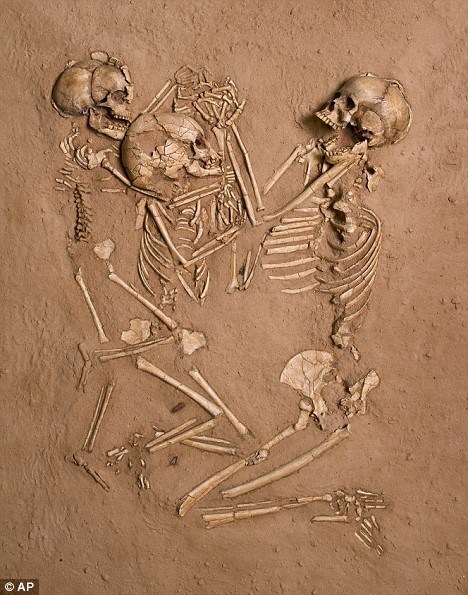
oosik:
Amazing 5,000-year-old skeletons laid on bed of flowers found in Sahara - proving desert was once green and lush
A tiny woman and two children were laid to rest on a bed of flowers 5,000 years ago in what is now the barren Sahara Desert.
Researchers discovered the slender arms of the youngsters still extended to the woman in a perpetual embrace.
The remarkable cemetery is providing clues to two civilisations who lived there, a thousand years apart, when the region was moist and green.
Paul Sereno of the University of Chicago and colleagues were searching for the remains of dinosaurs in the African country of Niger when they came across the startling find.
Some 200 graves of humans were found during fieldwork at the site in 2005 and 2006, as well as remains of animals, large fish and crocodiles.
‘Everywhere you turned, there were bones belonging to animals that don’t live in the desert,’ said Sereno.
‘I realized we were in the green Sahara.’
The graveyard, uncovered by hot desert winds, is near what would have been a lake at the time people lived there. It’s in a region called Gobero, hidden away in Niger’s forbidding Tenere Desert, known to Tuareg nomads as a ‘desert within a desert.’
The human remains dated from two distinct populations that lived there during wet times, with a dry period in between. … Read more.
Archaeologists Unearth 5,000 Slave Graves On St. Helena

The UK Guardian, "Archaeologists find graves containing bodies of 5,000 slaves on remote island
Africans died in custody of Royal Navy in 1800s, after being seized from ships of slave traders, and were buried on St Helena," on 8 March 2012 -- British archaeologists have unearthed a slave burial ground containing an estimated 5,000 bodies on a remote South Atlantic island.
The corpses were found on tiny St Helena, 1,000 miles off the coast of south-west Africa. Those who died were slaves taken off the ships of slave traders by the Royal Navy in the 1800s, when Britain was supressing the slavery in the Caribbean. Many of the captives died after being kept on the slavers' ships in appalling conditions, and later in refugee camps when they reached the island.

According to Britain's National Archives, between 1808 and 1869 the Royal Navy seized more than 1,600 slave ships and freed about 150,000 Africans.
The dig, held in advance of the construction of a new airport on the island, revealed the horrors of the Atlantic slave trade.
The Middle Passage was the name of the route taken by ships transporting slaves from Africa to the new world.
It was the second leg of a triangular journey undertaken by European ships. The first leg would involve them taking manufactured goods to Africa, which they would trade for slaves.

After the Africans were delivered to the West Indies and Brazil (and, until the abolition slavery in 1809, the US), the ships would take raw materials back to Europe.
Experts from Bristol University led the dig. One of them, Prof Mark Horton, said: "Here we have the victims of the Middle Passage – one of the greatest crimes against humanity – not just as numbers, but as human beings.
"These remains are certainly some of the most moving that I have ever seen in my archaeological career."

St Helena was the landing place for many of the slaves taken off slaver ships captured by the navy during the suppression of the trade between 1840 – when the island became the base for the squadron leading the Royal Navy's offensive against the slavers – and 1872.
About 26,000 freed slaves were brought to the island, with most being landed at a depot in Rupert's Bay. Rupert's Valley – an arid, shadeless and always windy tract – was also poorly suited for use as a hospital and refugee camp for such large numbers.

Only five individuals were buried in coffins – one adolescent and four stillborn or newborn babies. The others had been put directly in shallow graves before being hastily covered. In some cases mothers were buried with their children. Dr Andrew Pearson of the university said 83% of the bodies were those of children, teenagers or young adults. Youngsters were often prime material for slave traders, who sought victims with long potential working lives. (source: Island Mix)
The university archaeologists have so far unearthed 325 bodies in individual, multiple and mass graves. They estimate the site contains a total of about 5,000 bodies, but these seem likely to be left where they lie. Horton noted that the archaeological excavations cover only the portion of the burial area that would have been disturbed by the new road were investigated.
Dr Andrew Pearson of the university said 83% of the bodies were those of children, teenagers or young adults.
Youngsters were often prime material for slave traders, who sought victims with long potential working lives.
Most causes of death could not be established on the bodies as the main killers – dehydration, dysentery and smallpox – leave no pathological trace.
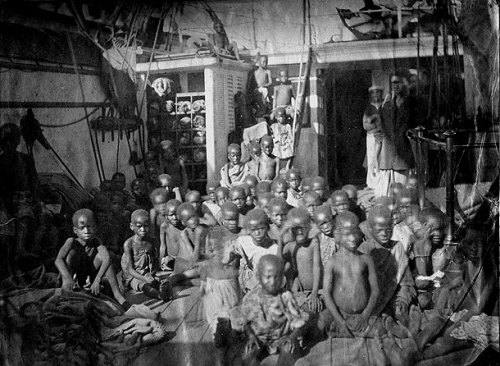
But experts found scurvy was widespread on the skeletons and several showed indications of violence, including two older children who appeared to have been shot.
The team found evidence the victims were from a rich culture, with a strong sense of ethnic and personal identity.
A few had managed to retain items of jewelry such as beads and bracelets, despite the physical stripping process that would have taken place after their capture.

A number of metal tags were also found on the bodies that would have identified the slaves by name or number.
Pearson, the director of the project, said: "Studies of slavery usually deal with unimaginable numbers, work on an impersonal level and, in so doing, overlook the individual victims.
"In Rupert's Valley, however, the archaeology brings us quite literally face-to-face with the human consequences of the slave trade."
Excavated artefacts will be transferred to Liverpool for an exhibition at the International Slavery Museum in 2013. The human remains will be re-interred on St Helena.

• This article was corrected and clarified on 12 March 2012. The original referred to slaves "captured" by the Royal Navy, who then went on to die "after being kept on British ships in appalling conditions". What it meant was slaves from captured slaver ships, where conditions caused many to die at the time or in the ensuing days and weeks. The story also implied that the Bristol University archeologists might be intending to excavate the whole St Helena burial site with its estimated 5,000 bodies. This is not the case. (source: UK Guardian,)
China denounces americas treatment of afro-descendants

China Denounces America’s Treatment of Afro-descendants (African Americans)
By Editor Raushana Karriem
In a scathing report issued by China’s Information Office of the State Council, China condemned America’s treatment of its Afro-descendants and other minorities and cited America’s numerous human rights violations against its minorities.
“The State Department of the United States released its Country Reports on Human Rights Practices for 2010 on April 8, 2011. As in previous years, the reports are full of distortions and accusations of the human rights situation in more than 190 countries and regions including China. However, the United States turned a blind eye to its own terrible human rights situation and seldom mentioned it. The Human Rights Record of the United States in 2010 is prepared to urge the United States to face up to its own human rights issues, “ states the report.
The report cites that Afro-descendants make up 50% of the homeless in Los Angeles, California and have a 32% unemployment rate nationwide.
According to a report of the Working Group of Experts on people of African descent to the Human Rights Council of the United Nations in August 2010, unemployment was a very serious issue for the Afro-descendant community in the United States, with levels of unemployment being, proportionately, four times higher among this population than in the white community. Reference was made to a case where the New York City Fire Department was found to have discriminated against people of African descent who had applied for employment as firemen. Of the 11,000 firemen employed by the New York City Fire Department, only about 300 were of African descent, despite their being about 27 percent of the population of New York (UN document A/HRC/15/18). Nearly one-sixth of black residents in the city were unemployed in the third quarter of 2010. About 140,000 of the city’s 384,000 unemployed residents, or 36 percent, were black (The New York Times, Oct 28, 2010).
Poverty proportion for minorities is also high in the United States. The US Census Bureau announced in Sept, 2010 that the poverty proportion of the black was 25.8 percent in 2009, and those of Hispanic origin and Asian were 25.3 percent and 12.5 percent respectively, much higher than that of the non-Hispanic white at 9.4 percent. The median household income for the black, Hispanic origin and non-Hispanic white were $32,584, $38,039 and $54,461 respectively (The USA Today, September 17, 2010). A survey released by the America Association of Retired Persons on February 23, 2010 found that over the previous 12 months, a third (33 percent) of African-Americans age 45+ had problems paying rent or mortgage, 44 percent had problems paying for essential items, such as food and utilities, almost one in four (23 percent) lost their employer-sponsored health insurance, more than three in 10 (31 percent) had cut back on their medications, and a quarter (26 percent) prematurely withdrew funds from their retirement nest eggs to pay for living expenses. Even in the tough employment environment, 12 percent of African-Americans age 65+ returned to the workforce from retirement, while nearly 20 percent of African-Americans age 45 to 64 increased the number of hours worked and 12 percent took a second job (The Los Angeles Times, Feb 23, 2010). In 2009, there were more than 30,000 black children living in poverty in the nation’s capital, almost 7,000 more than two years before. Among black children in the city, childhood poverty shot up to 43 percent, from 36 percent in 2008. In contrast, the poverty rate for Hispanic children was 13 percent, and the rate for white children was 3 percent (The Washington Post, Sept 29, 2010).
The USA Today on Oct 14, 2010 reported that African-American boys who were suspended at double and triple the rates of their white male peers. At the Christina School District in Delaware, 71 percent of black male students were suspended in a recent school year, compared to 22 percent of their white male counterparts. African-American students without disabilities were more than three times as likely to be expelled as their white peers. African-American students with disabilities were over twice as likely to be expelled or suspended as their white counterparts (USA Today, March 8, 2010).
The health care for African-American people is worrisome. Studies showed that nearly a third of ethnic minority families in the United States did not have health insurance. Life expectancy was lower and infant mortality higher than average (BBC, the social and economic position of minorities). Mortality of African-American children was two to three times higher than that of their white counterparts. African-American children represented 71 percent of all pediatric HIV/AIDS cases. African-American women and men were 17 times and 7 times, respectively, more likely to contract HIV/AIDS than white people, and twice more likely to develop cancer.
Racial discrimination is evident in the law enforcement and judicial systems. The New York Times reported on May 13, 2010, that in 2009, African-Americans and Latinos were 9 times more likely to be stopped by the police to receive stop-and-frisk searches than white people. Overall, 41 percent of the prison population was estimated to be African-American. The rate of African-Americans serving a life sentence was more than 10 times higher than that of whites. Males of African descent who dropped out of school had a 66 percent chance of ending up in jail or being processed by the criminal justice system (UN document A/HRC/15/18). A report said 85 percent of the people stopped in New York to receive stop-and-frisk searches over the past six years had been black or Latino (The Washington Post, November 4, 2010). According to a report of the Law School of the Michigan State University, among the 159 death row inmates in North Carolina, 86 were black, 61 were white and 12 were from other ethnic groups. During the trial process of the 159 capital cases, the number of black members taken out from the jury by prosecutors more than doubled that of non-black members. According to statistics from the Chicago Police Department, the proportion of black people being the criminals and the victims of all murder cases is the highest, reaching 76.3 and 77.6 percent respectively .
In conclusion, The People’s Republic of China demands that America stop using, their cry of Human Rights Violations against other sovereign nations in order to declare war on them to steal their resources when America flagrantly violates the Human Rights of Afro-descendants and other minorities within its own country.
"Do you know how many of my students can’t even say the word white?"
"Do you know how many of my students can’t even say the word white? You all will talk about...": “
Do you know how many of my students can’t even say the word white? You all will talk about African-Americans, Latinos, and Asian-Americans all day long but at soon as it comes time to say white peoples’ voices drop. You ain’t have seen that? Come on man, people come up with crazy terms you have never seen before, they would be like: “And that Caucasoid…” You can always tell, you could always tell where the supreme power rests in the society because of the reluctance people have in naming that power.
Part of what privilege requires, guys privilege cannot operate without silence. It cannot operate without silence, and this tremendous silence around whiteness, if you are foolish enough to post a blog on your Facebook that mentions whiteness the amount of attacks that you will get, because privilege defends itself viciously, to maintain the silence that is required for its operation.
So, given this I would argue that the other thing that we need to do is coming off of James Scott’s idea of “anarchist calisthenics,” we need to practice racial anarchist calisthenics. What he, what Scott meant by anarchist calisthenics is that this society has ton of little rules that we all practice without thinking. And he argues that we need to practice breaking little rules consistently because one day this society is going to ask you to prosecute a horrifying rule, that I think we will long live to regret, and the muscles of resistance needs to be exercised, they need to be prepared for the time we need to make that big, big, big, big stand.
And so racial anarchist calisthenics, I would say, begins with all of us getting that tongue muscle back in to place and saying Saurons name. I challenge people; I challenge people every time you say African-American, Asian-American, whatever the group count it and say white just as much. And say white just as much. We don’t do it you guys, we don’t do it, we don’t do it. And yet if we were ever going to confront in a real way white supremacy, which is not only linked to white folks you guys. White supremacy is the racial order in all of us, but if we are not able to discuss whiteness as a category, as a critical way of looking at the world and even simply as just the racial group, we are in some serious trouble. The reality is even if we took every white person on Earth and put them on a space ship and sent them to outer space white supremacy wouldn’t miss a beat.
”
- Junot Díaz - Facing Race (2012)
[word...white.]
Do you know how many of my students can’t even say the word white? You all will talk about African-Americans, Latinos, and Asian-Americans all day long but at soon as it comes time to say white peoples’ voices drop. You ain’t have seen that? Come on man, people come up with crazy terms you have never seen before, they would be like: “And that Caucasoid…” You can always tell, you could always tell where the supreme power rests in the society because of the reluctance people have in naming that power.
Part of what privilege requires, guys privilege cannot operate without silence. It cannot operate without silence, and this tremendous silence around whiteness, if you are foolish enough to post a blog on your Facebook that mentions whiteness the amount of attacks that you will get, because privilege defends itself viciously, to maintain the silence that is required for its operation.
So, given this I would argue that the other thing that we need to do is coming off of James Scott’s idea of “anarchist calisthenics,” we need to practice racial anarchist calisthenics. What he, what Scott meant by anarchist calisthenics is that this society has ton of little rules that we all practice without thinking. And he argues that we need to practice breaking little rules consistently because one day this society is going to ask you to prosecute a horrifying rule, that I think we will long live to regret, and the muscles of resistance needs to be exercised, they need to be prepared for the time we need to make that big, big, big, big stand.
And so racial anarchist calisthenics, I would say, begins with all of us getting that tongue muscle back in to place and saying Saurons name. I challenge people; I challenge people every time you say African-American, Asian-American, whatever the group count it and say white just as much. And say white just as much. We don’t do it you guys, we don’t do it, we don’t do it. And yet if we were ever going to confront in a real way white supremacy, which is not only linked to white folks you guys. White supremacy is the racial order in all of us, but if we are not able to discuss whiteness as a category, as a critical way of looking at the world and even simply as just the racial group, we are in some serious trouble. The reality is even if we took every white person on Earth and put them on a space ship and sent them to outer space white supremacy wouldn’t miss a beat.
”
- Junot Díaz - Facing Race (2012)
[word...white.]
A Beginning List Of The Best Geography Sites For Learning About Africa
A Beginning List Of The Best Geography Sites For Learning About Africa:
We’re going to start studying Africa in a few weeks in my Geography class, so here’s the latest installment in my Geography-related “Best…” series. I need to add a lot more here, and am very open to suggestions.
You can see all of them at The Best Geography Sites For Beginning & Intermediate English Language Learners.
Northern African Puzzle Map
African Puzzle Map
Southern Africa Puzzle Map
African Geography Games
African Countries — Beginning Level
African Map Game Level One
African Map Game Level Two
Africa Conversation
Ways Of Knowing Trail
Uganda Game
The Impossible Task
African Creation Story
Rwanda Game
Africa Facts
Africa’s AIDS Crisis
Life for African kids
We’re going to start studying Africa in a few weeks in my Geography class, so here’s the latest installment in my Geography-related “Best…” series. I need to add a lot more here, and am very open to suggestions.
You can see all of them at The Best Geography Sites For Beginning & Intermediate English Language Learners.
Northern African Puzzle Map
African Puzzle Map
Southern Africa Puzzle Map
African Geography Games
African Countries — Beginning Level
African Map Game Level One
African Map Game Level Two
Africa Conversation
Ways Of Knowing Trail
Uganda Game
The Impossible Task
African Creation Story
Rwanda Game
Africa Facts
Africa’s AIDS Crisis
Life for African kids
Cambodian workers on hunger strike
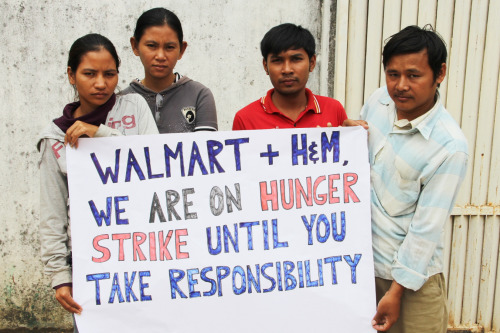
thepeoplesrecord:
Cambodian workers on hunger strike against Walmart & H&MFebruary 28, 2013
Self-organized garment workers at a Walmart and H&M supplier factory in Phnom Penh, Cambodia, have been camping in front of their shuttered factory for almost two months to prevent their bosses from taking out the sewing machinery.
Now the workers have escalated to blocking roads, and will launch a hunger strike February 27—all to push Walmart and H&M to pay them the back wages they are owed. Their cause is drawing support from workers at another Walmart subcontractor on the other side of the world.
“We decided to go on hunger strike to show that we not just any workers,” said one of the leaders, Sorn Sothy, 26, who works in the warehousing part of the Cambodian factory. “We are strong, committed, and united.”
The workers were informed in September that their factory, Kingsland Garment Co., Ltd., would temporarily close until January. Under Cambodian labor law, they would be paid 50 percent of their wages during this time, and brought back to work in January.
But in December, the paychecks stopped coming. The company union told the workers that the company was bankrupt and the owner had fled the country.
The garment workers are owed around $200,000 collectively—less than what Walmart makes in profits every six minutes.
Since their boss-run union wouldn’t fight back, 200 workers organized themselves and began protesting outside the factory gates January 1. In the middle of the night January 3, they noticed company staff attempting to remove the sewing machines from the factory.
“We decided to start sleeping outside of the factory to prevent management from taking the machinery out,” said Yorn Sok Leng, 30, who has worked at the factory for two years.
With the help of a worker center, the Community Legal Education Centre (CLEC), the workers occupied the outside of the factory—setting up tarps, a sleeping area, and a kitchen.
Source
Subscribe to:
Comments (Atom)



.JPG)











